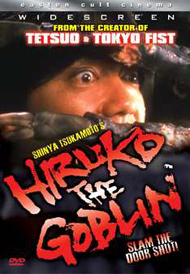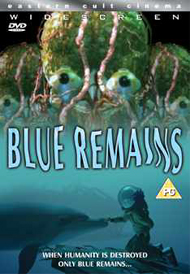| Release List | Reviews | Price Search | Shop | Newsletter | Forum | DVD Giveaways | Blu-Ray/ HD DVD | Advertise |
| Reviews & Columns |
|
Reviews DVD TV on DVD Blu-ray International DVDs Theatrical Reviews by Studio Video Games Features Collector Series DVDs Easter Egg Database Interviews DVD Talk TV DVD Talk Radio Feature Articles Columns Anime Talk DVD Savant HD Talk Horror DVDs Silent DVD
|
DVD Talk Forum |
|
|
| Resources |
|
DVD Price Search Customer Service #'s RCE Info Links |
|
Columns
|
 |
Savant PAL Region 2 Guest Reviews:
Hiruko the Goblin |

|
Hiruko the Goblin Eastern Cult Cinema 1990 / Colour / 1.77:1 anamorphic / Yokai Hunter: Hiruko, Yokai Hanta / 89m. Starring Kenji Sawada, Masaki Kudo, Tomoh Sano, Ken Mitisuishi, Hideo Murota, Megumi Ueno, Naoto Takenaka, Yasuaki Tsukahara, Daisuke Yamashita, Hogo Cho Cinematography Masahiro Kishimoto Production Designer Satoshi Akatsuka Editor Yoshitami Kuroiwa Original Music Tatsushi Umegaki Written by Shinya Tsukamoto based on a book by Daijiro Moroboshi Produced by Sadao Ochi and Shin Yoneyama Directed by Shinya Tsukamoto |
First things first: the goblins featured here are physically very different to any previous representations of goblins that I've ever come across. They're kind of like giant (foot high) spiders with reptilian heads and they appear to be governed by a collective consciousness. They can move incredibly fast, walk up walls and even sprout wings and fly when they need to. These creatures have the power to project intense hallucinations which result in their victims voluntarily decapitating themselves, thus allowing the goblin to attach itself to the newly severed head and use its human voice or some cunning positioning to attract further victims. They also have rather nasty projecting tongues that they can use as weapons.
The basic concept that Hiruko the Goblin is built around guarantees the presence of some disturbing and unpleasant scenarios but Shinya Tsukamoto had his tongue firmly in his cheek when he wrote and directed this show. He's exploring the type of horror-humour territory that begs comparison to Peter Jackson's Dead Alive and the Re-animator series but Tsukamoto has chosen to largely avoid the gory excesses associated with those films: a move which serves to further lighten this movie's tone. That said, the film still has its moments in terms of shocks, frights and suspense. Evil Dead-style camera tricks and intense sound effects are effectively used to represent the goblin's point of view as it rushes towards its terrified victims at great speed or tears around the school's corridors after dark. And scenes where the goblin, or its shadow, are seen slyly crawling into frame from an unexpected angle are quite unsettling.
Haunted by lost love and embarrassed by the public dismissal and ridicule of his theories about goblins, Reijiro Hieda is a strangely comic yet melancholic character. Self-effacing and polite, he has effectively withdrawn into a solitary world of his own that is dominated by his bizarre inventions. Arriving in town with a suitcase full of gadgets, like his electronic goblin detector and his cans of goblin repellent spray, he makes for an unassuming but quite convincing hero. Most of the other characters found here are quite well-rounded too: Masao and his chums are fairly believable kids, listlessly hanging around the school's grounds during their summer vacation and agonising over their secret love for female classmates like Reiko. The school itself is stalked by a very spooky janitor who would be perfectly at home as one of the bad guys in a first season episode of Scooby Doo.
Production values here are very good. The film has the ambience of an independent feature but would appear to have enjoyed a decent sized budget. The special effects employed are quite convincing and there are some good stop-motion effects on show. The cinematography is largely very good too and the rural setting results in some impressive shots of the location's surrounding countryside. A good bit of the story takes place in the dark but Kenjiro Konaka's quite superb lighting keeps all of the central action and peripheral detail clearly visible. Tatsushi Umegaki's fairly excellent soundtrack score is a quite varied affair, flipping between abrasive '80s-style electronics for the action sequences and dreamy classical-based pieces for the more subdued and introspective scenes. All in all, this is a good attempt at bringing something a little different to the mainstream horror scene.
This is a really nice presentation. The colours are strong, the image is sharp and you'd be hard pushed to find any sign of print damage. The night-time and other 'in the dark' sequences play particularly well. The picture quality does dip ever so slightly during a couple of the daytime exterior sequences but this doesn't pose a problem. The disc's sound quality is very good, featuring the film's original Japanese soundtrack with optional English subtitles.

|
Blue Remains Eastern Cult Cinema 2000 / Colour / 1.77:1 anamorphic / 77m. Starring (Voices) Kazue Fukiishi, Takehito Koyasu, Rika Matsumoto, Norio Wakamoto, Kazuya Ichijyo, Kappei Yamaguchi, Masane Tsukayama, Tomoko Kaneda, Yoshiko Sakakibari Cinematography Masanori Ikeda, Kolchi Okada Production Designers Tomoya Tsujita, Haruhiko Mikimoto, Tatsuya Tomosugi Editors Aihei Makino, Tatsuo Asai, Hanako Abe Original Music Masayoshi Okawa, Taku Kitahara Written by Hisaya Takabayashi, Toshifumi Takizawa and Masatoshi Kimura Produced by Katsuaki Takemoto, Tsutomu Kuno, Hidetami Kuwahara Directed by Toshifumi Takizawa and Hisaya Takabayashi |
Blue Remains' story line is pretty good and the quality of the show's approach to CGI animation is very impressive. As Jonathan Clements points out in his Final Fantasies lecture, the smooth and graceful nature of movement underwater means that sub-aquatic settings are ideal locations for CGI productions that are seeking to achieve a decent level of realism and Blue Remains certainly succeeds in this respect. The actual representation of humans here isn't quite as good as that of the budget-busting Final Fantasy feature film but it's not that far off. And, breaking with tradition somewhat, the young Amamiku is the only character here who noticeably sports anything like the generic facial shapes normally associated with Japanese Anime. The quality of the film's space and sub-aquatic crafts is largely excellent in terms of both design and realistic representation. Same goes for the film's varied underwater 'locations'.
The show's bad guy, Glyptofane Sex, is a very convincing villain. His argument for the destruction of the human race can't be faulted on the evidence to hand - after all, they've just almost succeeded in destroying the planet - but he's such a thoroughly evil megalomaniac himself that he simply has no right to sit in judgment or offer himself up as their natural successor. He has an army of destructive attack robots, Gadoms, which destroy his enemies by acting as mobile ripsaws and futuristic limpet mines. And his mothership is a distinctly foreboding affair: it's dark central mass and plethora of bionic tentacles are like a cross between a giant squid and the multiple-ghost shape that appears at the end of the remake of The House On Haunted Hill. When he needs to, Glyptofane can attach himself to the skulls of fearsome giant sea monsters which he then possesses and controls.
(Spoilers begin....) While the film does contain some elements of mild 'cuteness' - the pre-suspended animation Amamiku and her later relationships with the ship's robot, Pyron, the ship's computer intelligence, Mayzamik, and a cybernetic dolphin, Kail - it also contains some darker elements and scenarios beyond those immediately surrounding Glyptofane Sex. It's obvious from the outset that Glyptofane's hardware is many times more powerful than that of the surviving humans. Realism wins the day and several prominent human characters die noble deaths when Glyptofane launches his final assault. His determination and strength mean that a happy ending cannot be readily guaranteed and the viewer is held in a real state of anticipation and dread until the very end. (....spoilers end).
This is an entertaining and engaging piece of work. As with most Japanese cartoons, there are odd moments where a mild feeling of slight incoherence or confusion sets in just for a second or two but, generally, this film boasts a fairly straightforward and linear narrative. The CGI animation is really used to great effect during the frenetic and action-packed underwater battle sequences. The actual underwater 'settings' and their colour schemes are consistently good, as is the camera work, and Masayoshi Okawa and Taku Kitahara's remarkable electro-symphonic soundtrack score imbues the whole thing with a sense of really epic grandeur. The final credits play over a series of real underwater shots while a gentle protest song, Quiet Voice sung by Annette Brissett and produced by Sly and Robbie plays on the soundtrack. It would be a real shame if an effort of this overall quality and originality didn't find a wider audience for itself.
This is an excellent presentation with both the picture and the audio information coming through loud and clear. The disc features the film's original Japanese soundtrack with optional English subtitles. The Final Fantasies extra is an enjoyable 32 minute lecture about Japanese animation by author Jonathan Clements that was filmed at a London Sci-Fi film convention. Clements also supplies the informative commentary track.
Both discs are PAL Region 2, and are not intended for playback in the U.S.
On a scale of Excellent, Good, Fair, and Poor,
Hiruko the Goblin rates:
Movie: Very Good
Video: Excellent -
Sound: Very Good +
Supplements: Trailer and a mix of biographies and filmographies for Shinya Tsukamoto,
Hideo Murota, Kenji Sawada, Masaki Kudo, Megumi Ueno & Naoto Takenaka
Packaging: Keep case
Reviewed: October 5, 2003
On a scale of Excellent, Good, Fair, and Poor,
Blue Remains rates:
Movie: Very Good
Video: Excellent
Sound: Excellent
Supplements: Trailer, biography & filmography for Haruhiko Mikimoto, filmographies
for Toshifumi Takizawa & Hisaya Takabayashi, Final Fantasies lecture and commentary by Jonathan Clements
Packaging: Keep case
Reviewed: October 5, 2003
Review Staff | About DVD Talk | Newsletter Subscribe | Join DVD Talk Forum
Copyright © MH Sub I, LLC dba Internet Brands. | Privacy Policy | Terms of Use
|
| Release List | Reviews | Price Search | Shop | SUBSCRIBE | Forum | DVD Giveaways | Blu-Ray/ HD DVD | Advertise |





